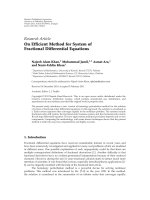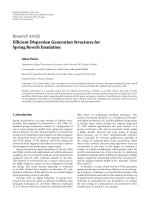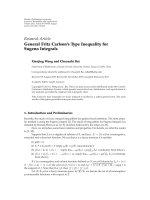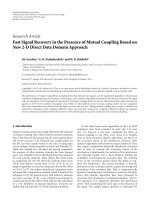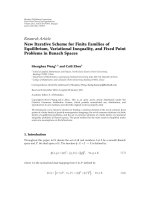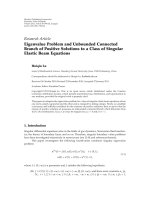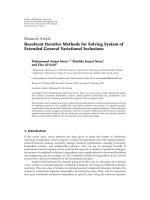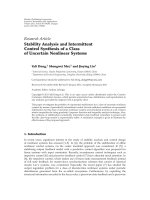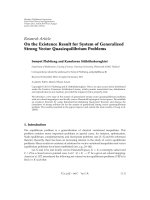báo cáo hóa học:" Research Article Human Action Recognition Using Ordinal Measure of Accumulated Motion" ppt
Bạn đang xem bản rút gọn của tài liệu. Xem và tải ngay bản đầy đủ của tài liệu tại đây (4.6 MB, 11 trang )
Hindawi Publishing Corporation
EURASIP Journal on Advances in Signal Processing
Volume 2010, Article ID 219190, 11 pages
doi:10.1155/2010/219190
Research Article
Human Action Recognition Using Ordinal Measure of
Accumulated Motion
Wonjun Kim, Jaeho Lee, Minjin Kim, Daeyoung Oh, and Changick Kim
Department of Electrical Engineering, Korea Advanced Institute of Science and Technology (KAIST), 119 Munji Street,
Yuseong-gu, Daejeon 305-714, South Korea
Correspondence should be addressed to Changick Kim,
Received 14 December 2009; Accepted 1 February 2010
Academic Editor: Jenq-Neng Hwang
Copyright © 2010 Wonjun Kim et al. This is an open access article distributed under the Creative Commons Attribution License,
which permits unrestricted use, distribution, and reproduction in any medium, provided the original work is properly cited.
This paper presents a method for recognizing human actions from a single query action video. We propose an action recognition
scheme based on the ordinal measure of accumulated motion, which is robust to variations of appearances. To this end, we first
define the accumulated motion image (AMI) using image differences. Then the AMI of the query action video is resized to a N
×N
subimage by intensity averaging and a rank matrix is generated by ordering the sample values in the sub-image. By computing the
distances from the rank matrix of the query action video to the rank matrices of all local windows in the target video, local windows
close to the query action are detected as candidates. To find the best match among the candidates, their energy histograms, which
are obtained by projecting AMI values in horizontal and vertical directions, respectively, are compared with those of the query
action video. The proposed method does not require any preprocessing task such as learning and segmentation. To justify the
efficiency and robustness of our approach, the experiments are conducted on various datasets.
1. Introduction
Recognizing human actions has become critical with increas-
ing demand of high-level scene understanding to analyze
behaviors and interactions of humans in the scene. It can
be widely applied for numerous applications, such as video
surveillance, video indexing, and event detection [1]. For
example, irregular actions in public places can be detected
by using the action recognition systems [2]. However,
such action recognition systems still suffer from problems
depending on variations of appearance. For example, the dif-
ferent clothes and genders yield significant differentiation of
appearance in conducting similar actions. Also, same actions
may be misclassified as different actions due to objects
carried by actors [3] (see Figure 1). In these situations,
traditional template matching based algorithm may fail to
detect a given query action. Thus, it is worth noting that
building an efficient and robust action recognition system is
a challenging task.
There are two types of human action recognition models:
learning-based models and template-based mode ls . In the
former, reliable action dataset is essentially needed to build
a classifier whereas the single template (i.e., training-free)
is used to find the query action in target video sequences
in the latter. Since it is hard to maintain the large dataset
for real applications, the latest algorithms for human action
recognition tend to be template-based. In this sense, we
also propose a template-based action recognition method for
static camera applications.
Main contributions of the proposed method are sum-
marized as follows: first, the accumulated motion image
(AMI) is defined by using image differences to represent the
spatiotemporal features of occurring actions. It should be
emphasized that only areas containing changes are mean-
ingful for computing AMI instead of the whole silhouette
ofhumanbodyasinpreviousmethods[4, 5]. Thus,
the segmentation task such as background subtraction to
obtain the silhouette of human body is not required in
our method. Secondly, we propose to employ the ordinal
measure of accumulated motion for detecting query actions
in target video sequences. Our method is motivated by the
earlier work using the ordinal measure for detecting image
2 EURASIP Journal on Advances in Signal Processing
and video copies [6, 7], in which authors show that the
ordinal measure is robust to various modifications of original
images. Thus, it can be employed to cope with variations
of appearance for the accurate action recognition. Finally,
the energy histograms, which are obtained by projecting
AMI values in horizontal and vertical directions, are used to
determine the best match among local windows detected as
candidates close to the query action.
The rest of this paper is organized as follows: the related
work is briefly summarized in Section 2. The technical details
about the steps outlined above are explained in Section 3.
Various real videos are tested to justify the efficiency
and robustness of our proposed method in Section 4 and
followed by conclusion in Section 5.
2. Review of Related Work
Human action recognition has been widely studied for last
several decades. Bobick and Davis [8] propose the temporal
templates as models for actions. They construct two vector
images, that is, motion energy image (MEI) and motion
history image (MHI), which are designed to encode a variety
of motion properties. In detail, an MEI is a cumulative
motion image whereas an MHI denotes recent moving
pixels. Finally, these view-specific templates are matched
against the model of query actions. Sch
¨
uldt et al. [9]use
space-time interest points proposed in [10]torepresent
the motion patterns and integrate such representations with
SVM classification schemes. Ikizler et al. [11]proposeto
use lines and optical flow histograms for human action
recognition. In particular, they introduce a new shape
descriptor based on the distribution of lines fitted to the
silhouette of human body. In [12], authors define the
integral video to efficiently calculate 3D spatiotemporal
volumetric features and train cascaded classifiers to select
features and recognize human actions. Hu et al. [13] use the
MHI along with foreground image obtained by background
subtraction and the histogram of oriented gradients (HOG)
[14] to obtain discriminative features for action recognition.
Then they build a multiple-instance learning framework to
improve the performance. Authors of [15] propose to use the
mixture particle filters and then cluster the particles using
local nonparametric clustering. However, these approaches
require supervised learning based on the large reliable dataset
before recognizing human actions.
Yilmaz and Shah [17] encode both shape and motion
features to represent the 3D action models. More specifically,
theytreatactionsas3Dobjectsin(x, y, t) space and compute
action descriptors by analyzing the differential geometrical
properties of spatiotemporal volume. Gorelick et al. [18]
also induce the silhouette in the space-time volume for
human action recognition. Unlike [17], they use the blobs
obtained by background subtraction instead of contours.
However, these silhouette-based approaches require accurate
background subtraction.
A recent trend in human action recognition has been
toward the template-based models as mentioned. Shechtman
and Irani [19] introduce a novel similarity measure based
on the correlation of behavior. They use intensity values in a
small space-time patch. In detail, a space-time video template
for the query action consists of such small space-time
patches. It is correlated against a larger target video sequence
by checking its consistency with every video segment to find
the best match with the given query action. Furthermore,
they propose to measure similarity between actions based
on matching internal self-similarities [20]. Ning et al. [21]
propose the hierarchical space-time framework enabling
efficient search for desirable actions. Similar to [19], they also
use the correlation between the query action template and
candidates in the target video. However, these approaches
may be unstable under noisy environments. In [3], authors
propose the space-time local steering kernels (LSK) to
represent the volumetric features. They compare the 3D
LSK features of the query action efficiently against those
obtained from the target video sequences using a matrix
generalization of the cosine similarity measure. Although the
shape information is well defined in the LSK features, it is
hard to apply it for real-time applications due to the high
dimensionality.
Basically, our approach belongs to the template-based
model. Unlike previous methods, the ordinal measure
employed in our method easily generalizes across appearance
variations due to different clothes and body figures. Further
technical details will be presented in the following section.
3. Proposed Method
The proposed method consists of three stages: AMI compu-
tation, candidate detection by using the ordinal measure of
accumulated action, and determination of the best match
based on the energy histograms. Overall procedure of the
proposed method is shown in Figure 2.
3.1. Accumulated Motion Image (AMI). Since the accumu-
lated motion is differentiable across various actions, it can
be regarded as a discriminative feature for recognizing
human actions. Based on this observation, we introduce a
new feature, AMI, enabling efficient representation of the
accumulated motion.
Our feature, AMI, is motivated by the gait energy image
(GEI) popularly used for the individual recognition [22]
and gender classification [23]. However, as compared to
GEI, only areas including changes are used to compute AMI
instead of requiring the whole silhouette of human body.
To this end, the gray-level AMI is defined by using image
differences as follows:
AMI
x, y
=
1
T
T
t=1
D
x, y, t
,(1)
where D(x, y, t)
= I(x, y, t) − I(x, y, t − 1) and T denotes
the length of the query action video (i.e., total number of
frames). We name it as accumulated motion image because:
(1) AMI represents the time-normalized accumulative action
energy and (2) pixels with higher intensity values in the AMI
denote that motions occur more frequently at the positions.
Although our AMI is related to MEI and MHI proposed
EURASIP Journal on Advances in Signal Processing 3
(a) (b)
Figure 1: (a) Variations of appearance due to different clothes in the same action. (b) Different appearance in conducting the same action
due to backpack.
Query action
T :period
Target video
Stage 3
Final determination of the best
match using energy histogram
Stage 1
Stage 2
Candidate detection by
ordinal measure
AMI generation
T
Result of action
recognition
Figure 2: Overall procedure of the proposed method.
by Bobick and Davis [8], there is a fundamental difference.
More specifically, the equal weights for all change areas are
given in MEI. The higher weights are assigned to new frames
whereas low weights are assigned to older frames in MHI.
Therefore, both of them are not suitable for representing the
accumulated motion for our ordinal measure, which will be
explained in the following subsection. As compared to MEI
and MHI, AMI describes the accumulated motion by using
the pixel intensity. The examples of AMI for some actions are
shown in Figure 3.
3.2. Ordinal Measure for Detecting Candidates. Traditional
template-based action recognition techniques have relied
on the shape correspondence. The distances between the
query action and all local windows in the target videos
are computed based on the shape similarities of corre-
sponding windows. However, most of them are apt to fail
in tolerating variations of appearance due to the clothes
and objects carried by actors, which is often observed in
surveillance environments. To solve this problem, we employ
the ordinal measure for computing the similarity between
different actions, which is very robust to various signal
modifications [7]. For example, two subimages of the same
action obtained by resizing AMIs are shown in Figure 4,
which have variations of appearance due to different clothes
and backpack. The values of resized AMI are quite different
between two subimages whereas the ordinal signatures
between corresponding subimages are identical. Thus, we
believe that the ordinal measure of accumulated motion can
provide a more efficient way of recognizing human actions.
To this end, AMI is firstly resized to a N
× N subimage
by intensity averaging as shown in Figure 4. Let us define the
1
×M rank matrix of resized AMI for the query action video
V
q
as R(V
q
)whereM equals to N × N.Itissetto9inour
implementation. For example, the rank matrix of the query
action can be represented as R(V
q
) = [5,1,6,4,2,3,9,7,8]
in Figure 4 and also each element of the rank matrix can be
expressed as R
1
(V
q
) = 5, R
2
(V
q
) = 1, , R
9
(V
q
) = 8. Thus,
the accumulated motion of query video is effectively encoded
in a single rank matrix.
Then the rank matrix of the query action video should
be matched against the rank matrices of all local windows
to detect candidates close to the query action. Here centers
of local windows are positioned four pixels apart from
each other in the target video frame and thus they are
densely overlapped in horizontal and vertical directions,
respectively (see Figure 2). For example, total 1681(
= 41 ×
41) comparisons need to be performed for the target video
frame of 200
× 200 pixels with given local windows of 40 ×
40 pixels. The ith frame of the target video can be represented
as follows:
V
t
[
i
]
=
V
t
1
[
i
]
, V
t
2
[
i
]
, , V
t
P
[
i
]
, i = 1, 2, , L,(2)
where P and L denote the total number of local windows in
the ith frame of the target video and the length of the target
video, respectively. Thus, the rank matrix of resized AMI for
the kth local window in the ith image frame of the target
video can be defined as R(V
t
k
[i]). Then the distance between
two rank matrices is expressed by using L1-norm as follows:
d
k
[
i
]
=
1
M
M
j=1
R
j
(
V
q
)
−R
j
V
t
k
[
i
]
,(3)
where k
= 1, 2, ,P and i = T, T +1, ,L. T denotes the
length of the query action video as mentioned. j denotes the
index of the rank matrix. This L1-norm is known to be more
robust to outliers than L2-norm [24] and also computed
efficiently. The rank matrix of query action is consistently
applied to compute the distance regardless of the frame
and local window indexes of the target video as shown in
(3). Finally, if the distance defined in (3) is smaller than
the threshold, the corresponding local windows are detected
4 EURASIP Journal on Advances in Signal Processing
···
···
···
···
···
Figure 3: Examples of AMI for five actions from Weizmann dataset [16]: bend, jack, vertical jump, one-hand wave, two-hand wave (from
toptobottom).
as candidates close to the query action. It is important to
note that a comparison between the rank matrices of the
query action video and local windows is conducted after
initial T frames in (3). It is because that the length of query
action video is required at least to generate the reliable AMI
of each local window for the accurate comparison. Thus,
the latest T frames of the target video need to be stored.
However, It should be emphasized that computing (3)with
all local windows in each target video frame is very fast since
1
× M rank matrices are only used as our features for the
similarity measure instead of full 3D feature vectors (i.e.,
spatiotemporal cubes shown in [3, 19]).
3.3. D etermination of the Best Match Using Energy Histograms.
To determine the best match among candidates efficiently,
we define the energy histograms by projecting AMI values
in horizontal and vertical directions, espectively, as shown
in Figure 5. First, the horizontal projection is performed to
accumulate all the AMI values in each row of the candidate
window. The projection is also conducted in the vertical
direction. To be invariant to the size of the local window,
accumulated AMI values of each bin are normalized by
the maximum value among AMI values belonging to the
corresponding bin. Our energy histogram for each direction
is defined as follows:
EH
h
(
i
)
=
W−1
j=0
AMI
i, j
max AMI
(
i
)
, i
= 0, , H −1, (4)
EH
v
j
=
H−1
i=0
AMI
i, j
max AMI
j
, j = 0, , W −1, (5)
where H and W denote the height and width of the local
window, respectively. max
AMI (·) denotes the maximum
value among AMI values belonging to the ith or jth bin
in each energy histogram. The two energy histograms of
the candidates, EH
c
h
and EH
c
v
, are compared with those
of the query action video, EH
q
h
and EH
q
v
, to determine
EURASIP Journal on Advances in Signal Processing 5
··· ···
31.39
32.45
3.83
72.99
65.11
9.44
13.85
33.59
7.43
28.45
33.44
1.16
70.61
65.56
4.45
12.76
53.59
4.37
5
4
9
1
2
7
6
3
8
5
4
9
1
2
7
6
3
8
Averaged AMI in 3
×3 sub-image Averaged AMI in 3 ×3sub-image
Rank matrix Rank matrix
=
Figure 4: Two different 3 ×3 subimages (i.e., M = 9) of the same action having identical ordinal signature.
(a) (b) (c)
Ve r t i c a l p rojec tion
Horizontal projection
Figure 5: (a) AMIs for jack and one-hand wave from top to bottom.
(b) Horizontal energy histogram. (c) Vertical energy histogram.
the best match. For the similarity measure between energy
histograms in each direction, we employ the histogram
intersection to attain simple computation, which is defined
as follows:
S
k
EH
T
k
,EH
C
k
=
l
i
=0
min
EH
q
k
(
i
)
,EH
c
k
(
i
)
max
l
i
=0
EH
q
k
(
i
)
,
l
i
=0
EH
c
k
(
i
)
,(6)
where k
={h, v} and corresponding l ={H − 1, W −
1}. Finally, the best match is determined based on the
combination of S
h
and S
v
as follows:
S
val
= α ·S
h
+
(
1 −α
)
·S
v
,(7)
where α denotes the weight, which is set to 0.5 in our
implementation. If the similarity value defined in (7)is
smaller than the threshold, the corresponding candidates are
removed. It is worth noting that since our energy histograms
express the shape information of AMIs correctly using
one-dimensional histograms, falsely detected candidates in
the target video can be effectively removed and thus the
reliability of the proposed method increases. The example of
the false positives elimination is shown in Figure 6.Wecan
see that falsely detected windows in the two-hand wave video
are effectively removed by using the energy histograms.
For the sake of completeness, the overall procedure of our
proposed method is summarized in Algorithm 1.
4. Experimental Results
In this section, we divide the experiments into three phases.
First of all, we test our proposed method in the Weizmann
dataset [16] to evaluate the robustness and discriminability.
The performance for the query action recognition among
multiple actions is also evaluated in the second phase. Finally,
the performance of our method for real applications such as
surveillance scenarios and event retrieval is evaluated.
4.1. Robustness and Discriminability. The robustness deter-
mines the reliability of the system which can be represented
by the accuracy of the query action detection before false
detections begin to occur whereas the discriminability is
concerned with its ability to reject irrelevant actions such
that false detections do not occur. To evaluate the robustness
and discriminability of our proposed method, we employ
the Weizmann human action dataset [16], which is one of
the most widely used standard datasets. In this dataset, total
10 actions conducted by nine people (i.e., 90 videos) are
contained, which can be divided into two categories: global
6 EURASIP Journal on Advances in Signal Processing
“Bend”
target video
“Bend” template
“Two-hand wave”
target video
Detected windows Final results
Elimination by thresholding
S
val
1.612
1.606
1.569
1.532
1.531
0.868
0.876
Figure 6: Verification procedure using energy histograms.
Stage 1. Compute AMI of the query action and local windows on the target video.
Stage 2. Ordinal measure for the query action recognition
(1) Generate the rank matrix based on resized AMI.
(2) Compute the distance between rank matrices of the query action and local windows from the target video.
d
k
[i] =
1
M
M
j
=1
R
j
(V
q
) − R
j
(V
t
k
[i])
Stage 3. Determination of the best match using energy histograms
S
val
= α · S
h
+(1− α) ·S
v
Algorithm 1: Human action recognition using ordinal measure of accumulated motion.
actions (like run, forward jump, side jump, skip, walk) and
local actions (like bend (bd), jack (jk), vertical jump (vjp),
one-hand wave (wv1), two-hand wave (wv2)). Since most
events observed in static camera applications are related to
localactions,wethusfocusonthefivelocalactionsinthe
Weizmann dataset (see Figure 3).
Since the proposed method does not determine the
type of action performed in the target video but localizes
windows including the query action in the target video,
the confusion matrix, which is widely used in the learning-
based models, cannot be applied for evaluating robustness
and discriminability of our method. Instead, we define our
metric, confusion rate (CR) as follows:
CR
(
i
)
=
5
j
=1
FP
i, j
Card
(
D
)
,wherei, j
= 1, 2, ,5. (8)
Here five local motions (i.e., bd, jk, vjp, wv1, wv2) are
mapping to the number from 1 to 5 in turn. FP (i, j)
denotes the number of videos containing falsely detected
windows with a given query action where i and j denote
indexes of the query actions and actions included in target
videos, respectively (see Figure 7). D denotes a set of videos
excluding videos related to the query action. For example, if
false detections occur in the one of “bd” target videos and
the two of “wv2” target videos when the “wv1” is given as the
query action, we can represent FP(4, 1)
= 1andFP(4,5)= 2.
−
0300 (3/36) ×100 = 8.3%
0
− 00 0 (0/36) ×100 = 0%
20
−
00 (2/36) ×100 = 5.6%
100
−
2(3/36) ×100 = 8.3%
0000
− (0/36) ×100 = 0%
bd jk vjp wv1 wv2
bd
jk
vjp
wv1
wv2
Ta rge t v i deos
Query actions
< FP matrix ><CR value >
Figure 7: Confusion rate for five local actions from Weizmann
dataset.
Furthermore, the CR can be computed as follows: CR(4) =
{
(1 + 2)/(45 − 9)}×100 = 8.3%. The CR values for five
local actions are shown in Figure 7. Note that the CR is
evaluated only at the level where the query action is perfectly
recognized in the videos including the actual query action.
The total classification rate of the proposed method can
be defined as follows [3]:
C
=
(
N
−# of misclassification
)
N
×100, (9)
EURASIP Journal on Advances in Signal Processing 7
Figure 8: Examples of the query action localization using the proposed method (from the top to bottom: bd, jk, vjp, wv1, wv2).
where N denotes the total number of videos used for
comparison. The total classification rate can be computed
based on our results (see Figure 7) as follows: C
= [{(9 ×
5 ×5) −8}/(9 ×5 ×5)] ×100 = 96.4%, which is comparable
to the classification rates of other methods such as [3, 19].
The results of the query action localization in target videos
are also shown in Figure 8.
The two threshold values used for candidate detection
and determination of the best match are empirically set.
The size of local windows is set to be equal to the image
size of the query action video. Note that the spatial and
temporal scale changes up to
±20% can be handled in our
method. The framework for evaluating performance has
been implemented by using Visual Studio 2005 (C++) under
FFMpeg library, which has been utilized for MPEG and Xvid
decoding. The experiments are performed on the low-end
PC (Core2Duo 1.8 GHz). The test videos in the Weizmann
dataset are encoded with the image size of 180
× 144 pixels.
The query action video for each local motion is cropped from
one of nine videos related to the corresponding action in
our experiment. Since the processing speed of our algorithm
achieves about 45 fps for the test videos, it can be sufficiently
applied for real-time applications.
4.2. Recognition Performance in Multiple Actions. In this
subsection, we demonstrate the recognition accuracy of the
proposed method by using our videos captured in different
environments (i.e., indoor and outdoor) with the image
size of 192
× 144 pixels. In particular, the performance
for the query action recognition among multiple actions is
evaluated.
First, two people conduct different actions in consecutive
sequences shown in Figure 9. More specifically, one person
waves a one hand consistently in the indoor environment
while the other one performs continuously different actions
shown in Figures 9(a) and 9(b). We can see that the query
action “wv2” and “jk” are correctly detected. In Figure 9(c),
the query action “vjp” is detected. Especially, a case that
“vjp” is conducted by different two actors at the same
time is also successfully detected. Furthermore, our method
captures invariably the query action although the color of
8 EURASIP Journal on Advances in Signal Processing
Wave 1 + jack Wave 1 + jack Wave 1 + sta nd Wave 1 + wave 2
(a)
Wave 1 + jack Wave 1 + jack Wave 1 + sta nd Wave 1 + wave 2
(b)
v jumb + bend v jumb + stand v jumb + v jump Stand + v jump
(c)
Figure 9: Query action recognition among multiple actions in the indoor environment. (a) Two-hand wave. (b) Jack. (c) Vertical jump.
Stand + v jump Bend + v jump v jumb + v jump Wave 2 + v jump
(a)
Walk+wave1 Bend+wave1 Jack+wave1 Jack+wave1
(b)
Figure 10: Query action recognition among multiple actions in the outdoor environment. (a) Bend. (b) One-hand wave.
background is similar with that of actors (see Figure 9(c)).
We also demonstrate the performance of our method in the
outdoor environment. The query action “bd” is correctly
detected among various actions conducted by one person
as shown in Figure 10(a).InFigure 10(b), the query action
“wv1” is successfully detected even if there is global motion
(i.e., walk) in the target video. Note that the all templates
for query actions are obtained from the Weizmann dataset.
Based on these results, it is shown that the query action can
be robustly recognized among various multiple actions by
our proposed method.
4.3. Recognition Performance for Real Applications. Since
most standard action dataset including the Weizmann
dataset is captured in well-controlled environments while
actions in the real world often occur in much more complex
scenes, there exists a considerable gap between these samples
and real world scenarios.
EURASIP Journal on Advances in Signal Processing 9
(a)
(b)
(c)
Figure 11: Performance in the selected videos of the surveillance system. Each video is composed of 1070, 800, 850 frames, respectively. (a)
Put-objects. (b) Call-people. (c) Push-button.
···
Query action
(a)
···
Query action
(b)
Figure 12: Query action recognition for event retrieval. (a) Turn-jump in ballet. (b) Examples of recognizing pitching action.
First of all, to show the robustness and efficiency of the
proposed method for the surveillance systems, we try to
recognize three specific actions, which are often observed in
surveillance scenarios: put-objects, call-people, push-button.
Figure 11 shows the recognition results of our method in
each surveillance video with the image size of 192
× 144
pixels. More specifically, the query action “put-objects” is
correctly detected in cluttered background as shown in
Figure 11(a). It should be emphasized that the proposed
method can detect the query action even though the actor
is merged with the other one. In Figure 11(b),amancalls
someone by waving his hand while the other one is going past
by him in the different direction. In such situation, the query
action “call-people” is also detected correctly. One person
pushes a button and then awaits the elevator in Figure 11(c).
Although the local window is partially occluded by the
other person, the query action is successfully detected. This
example shows the robustness of our method to the partial
10 EURASIP Journal on Advances in Signal Processing
Table 1: False positive rate of each selected video.
Put-objects Call-people Push-button
FPR 0.69% 0.22% 0.24%
occlusion in the complex scene. The accuracy of action
recognition in surveillance systems is shown in Ta bl e 1 .The
false positive rate (FPR) is computed as follows:
FPR
=
# of frames including misclassification in W
Card
(
W
)
, (10)
where W denotes a set of frames excluding the frames related
to the query action in each surveillance video. Here the FPR
is computed at the level where query actions are perfectly
detected in each surveillance video. Based on the results
of query action recognition, we confirm that the proposed
method can be regarded as a useful indicator for smart
surveillance system.
Furthermore, our proposed method can be applied for
the event retrieval. Note that since the proposed method
is originated for static camera applications as mentioned
in Section 1, the large motion of camera is highly likely
to yield unwanted detections. Thus, we demonstrate the
performance of our method by using two query action
videos captured with static camera, which are collected from
broadcasting videos: turn-jump in ballet and pitching in
baseball. Figure 12(a) shows the process of the query action
recognition in the ballet sequence. The turn-jump action
is correctly detected among various jump actions as shown
in Figure 12(a).InFigure 12(b), the pitching action is also
successfully detected in various baseball videos.
5. Conclusion
A novel method for human action recognition is proposed
in this paper. Compared to previous methods, our proposed
algorithm is performed very fast based on the simple ordinal
measure of accumulated motion. To this end, AMI is firstly
defined by using image differences. Then the rank matrix
is generated based on the relative ordering of resized AMI
values and distances from the rank matrix of query action
video to the rank matrices of all local windows in the target
video are computed. To determine the best match among
the candidates close to the query action, we propose to use
the energy histograms obtained by projecting AMI values
in horizontal and vertical directions, respectively. Finally,
experiments are performed on diverse videos to justify the
efficiency and robustness of the proposed method. The clas-
sification results of our algorithm are comparable to state-
of-the-art methods and further, the proposed method can be
used for real-time applications. Our future work is to extend
the algorithm to describe human actions in dynamic scenes.
Acknowledgments
This research was supported by the MKE (The Ministry of
Knowledge Economy), Korea, under the ITRC (Information
Technology Research Center) support program supervised
by the NIPA (National IT Industry Promotion Agency)
(NIPA-2010-(C1090-1011-0003)).
References
[1] A. Briassouli and I. Kompatsiaris, “Robust temporal activity
templates using higher order statistics.,” IEEE Transactions on
Image Processing, vol. 18, no. 12, pp. 2756–2768, 2009.
[2] O. Boiman and M. Irani, “Detecting irregularities in images
and in video,” in Proceedings of the 10th IEEE International
Conference on Computer Vision (ICCV ’05), vol. 1, pp. 462–
469, Beijing, China, October 2005.
[3] H. J. Seo and P. Milanfar, “Detection of human actions from a
single example,” in Proceedings of the International Conference
on Computer Vision (ICCV ’09), October 2009.
[4] V. H. Chandrashekhar and K. S. Venkatesh, “Action energy
images for reliable human action recognition,” in Proceedings
of the Asian Symposium on Information Display (ASID ’06),pp.
484–487, October 2006.
[5] M. Ahmad and S W. Lee, “Recognizing human actions based
on silhouette energy image and global motion description,”
in Proceedings of the 8th IEEE International Conference on
Automatic Face and Gesture Recognition (FG ’08), pp. 1–6,
Amsterdam, The Netherlands, September 2008.
[6] C. Kim, “Content-based image copy detection,” Signal Process-
ing: Image Communication, vol. 18, no. 3, pp. 169–184, 2003.
[7] C. Kim and B. Vasudev, “Spatiotemporal sequence matching
for efficient video copy detection,” IEEE Transactions on
Circuits and Systems for Video Technology,vol.15,no.1,pp.
127–132, 2005.
[8] A. F. Bobick and J. W. Davis, “The recognition of human
movement using temporal templates,” IEEE Transactions on
Pattern Analysis and Machine Intelligence, vol. 23, no. 3, pp.
257–267, 2001.
[9] C. Sch
¨
uldt, I. Laptev, and B. Caputo, “Recognizing human
actions: a local SVM approach,” in Proceedings of the 17th
International Conference on Pattern Recognition (ICPR ’04),
vol. 3, pp. 32–36, Cambridge, UK, August 2004.
[10] I. Laptev and T. Lindeberg, “Space-time interest points,”
in Proceedings of the 9th IEEE International Conference on
Computer Vision, vol. 1, pp. 432–439, Nice, France, October
2003.
[11] N. Ikizler, R. G. Cinbis, and P. Duygulu, “Human action
recognition with line and flow histograms,” in Proceedings of
the 19th International Conference on Pattern Recognition (ICPR
’08), pp. 1–4, Tampa, Fla, USA, December 2008.
[12] Y. Ke, R. Sukthankar, and M. Hebert, “Efficient visual event
detection using volumetric features,” in Proceedings of the 10th
IEEE International Conference on Computer Vision (ICCV ’05),
vol. 1, pp. 166–173, Beijing, China, October 2005.
[13] Y. Hu, L. Cao, F. Lv, S. Yan, Y. Gong, and T. S. Huang,
“Action detection in complex scenes with spatial and temporal
ambiguities,” in Proceedings of International Conference on
Computer Vision (ICCV ’09), October 2009.
[14] N. Dalal and B. Triggs, “Histograms of oriented gradients for
human detection,” in Proceedings of IEEE Computer Society
Conference on Computer Vision and Pattern Recognition (CVPR
’05), vol. 1, pp. 886–893, San Diego, Calif, USA, June 2005.
[15] P. S. Dhillon, S. Nowozin, and C. H. Lampert, “Combining
appearance and motion for human action classification in
videos,” in Proceedings of the IEEE Conference on Computer
Vision and Pattern Recognition (CVPR ’09), pp. 22–29, Miami,
Fla, USA, June 2009.
EURASIP Journal on Advances in Signal Processing 11
[16] M. Blank, L. Gorelick, E. Shechtman, M. Irani, and R. Basri,
“Actions as space-time shapes,” in Proceedings of the 10th IEEE
International Conference on Computer Vision (ICCV ’05), vol.
2, pp. 1395–1402, Beijing, China, October 2005.
[17] A. Yilmaz and M. Shah, “Actions sketch: a novel action
representation,” in Proceedings of IEEE Computer Society
Conference on Computer Vision and Pattern Recognition (CVPR
’05), vol. 1, pp. 984–989, San Diego, Calif, USA, June 2005.
[18] L. Gorelick, M. Blank, E. Shechtman, M. Irani, and R. Basri,
“Actions as space-time shapes,” IEEE Transactions on Pattern
Analysis and Machine Intelligence, vol. 29, no. 12, pp. 2247–
2253, 2007.
[19] E. Shechtman and M. Irani, “Space-time behavior based
correlation,” in Proceedings of the IEEE Computer Societ y
Conference on Computer Vision and Pattern Recognition (CVPR
’05), vol. 1, pp. 405–412, San Diego, Calif, USA, June 2005.
[20] E. Shechtman and M. Irani, “Matching local self-similarities
across images and videos,” in Proceedings of the IEEE Computer
Society Conference on Computer Vision and Pattern Recognition
(CVPR ’07), pp. 1–8, Minneapolis, Minn, USA, June 2007.
[21] H.Ning,T.X.Han,D.B.Walther,M.Liu,andT.S.Huang,
“Hierarchical space-time model enabling efficient search for
human actions,” IEEE Transactions on Circuits and Systems for
Video Technology, vol. 19, no. 6, pp. 808–820, 2009.
[22] J. Han and B. Bhanu, “Individual recognition using gait energy
image,” IEEE Transactions on Pattern Analysis and Machine
Intelligence, vol. 28, no. 2, pp. 316–322, 2006.
[23] S. Yu, T. Tan, K. Huang, K. Jia, and X. Wu, “A study on
gait-based gender classification,” IEEE Transactions on Image
Processing, vol. 18, no. 8, pp. 1905–1909, 2009.
[24] P. J. Rousseeuw and A. M. Leroy, Robust Regression and Outlier
Detection, John Wiley & Sons, New York, NY, USA, 1987.

